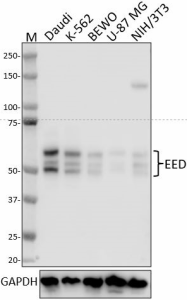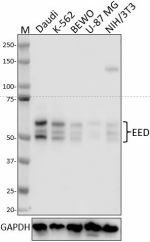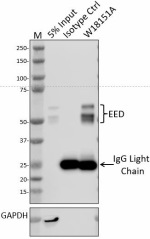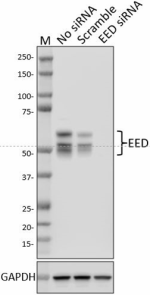- Clone
- W18151A (See other available formats)
- Regulatory Status
- RUO
- Other Names
- Embryonic Ectoderm Development, Embryonic Ectoderm Development Protein, Polycomb Protein EED
- Isotype
- Rat IgG2a, κ
- Ave. Rating
- Submit a Review
- Product Citations
- publications

-

Whole cell extracts (15 µg total protein) from the indicated cell lines were resolved by 4-12% Bis-Tris gel electrophoresis, transferred to a PVDF membrane, and probed with 1.0 µg/mL of purified anti-EED antibody (clone W18151A) overnight at 4°C. Proteins were visualized by chemiluminescence detection using HRP goat anti-rat IgG antibody (Cat. No. 405405) at a 1:3000 dilution. Direct-Blot™ HRP anti-GAPDH antibody (Cat. No. 607904) was used as a loading control at a 1:50000 dilution (lower). Lane M: Molecular weight marker. -

Whole cell extracts (250 µg total protein) prepared from HeLa cells were immunoprecipitated overnight with 2.5 µg of purified rat IgG2a, κ isotype ctrl antibody (Cat. No. 400502) or purified anti-EED antibody (clone W18151A). The resulting IP fractions and whole cell extract input (5%) were resolved by 4-12% Bis-Tris gel electrophoresis, transferred to a PVDF membrane and probed with 1.0 µg/mL of purified anti-EED antibody (clone W18151A) overnight at 4°C. Proteins were visualized by chemiluminescence detection using HRP anti-rat light chain specific antibody. Direct-Blot™ HRP anti-GAPDH antibody (Cat. No. 607904) was used as a loading control at a 1:50000 dilution (lower). Lane M: Molecular weight marker. -

Whole cell extracts (15 µg protein) from HeLa cells transfected with scramble control siRNA or siRNA targeting EED were resolved on a 4-12% Bis-Tris gel electrophoresis, transferred to a PVDF membrane and probed with 1.0 µg/mL of purified anti-EED antibody (clone W18151A) overnight at 4°C. Proteins were visualized by chemiluminescence detection using HRP goat anti-rat IgG antibody (Cat. No. 405405) at a 1:3000 dilution. Direct-Blot™ HRP anti-GAPDH antibody (Cat. No. 607904) was used as a loading control at a 1:50000 dilution (lower). Lane M: Molecular weight marker. siRNA targeting EED for depletion was obtained from Dharmcon (SMARTpool ON-TARGETplus EED siRNA, Cat. No. L-017581-00-0005) -

HeLa cells were fixed with 4% paraformaldehyde for 10 minutes, permeabilized with Triton X-100 for 10 minutes, and blocked with 5% FBS for 60 minutes. Cells were then intracellularly stained with a 1 µg/mL of either purified rat IgG2a, κ isotype ctrl antibody (Cat. No. 400502, panel A) or purified anti-EED antibody (clone W18151A, panel B) overnight at 4°C, followed by incubation with Alexa Fluor® 594 goat anti-rat IgG antibody (Cat. No. 405422) at 2.0 µg/mL. Nuclei were counterstained with DAPI and the image was captured with a 60X objective.
| Cat # | Size | Price | Quantity Check Availability | Save | ||
|---|---|---|---|---|---|---|
| 934901 | 25 µg | $101 | ||||
| 934902 | 100 µg | $241 | ||||
Embryonic ectoderm development (EED) is a member of the polycomb-group (PcG) family. The PcG family members form multimeric protein complexes called polycomb repressive complexes (PRCs). These polycomb repressive complexes (PRCs) epigenetically silence gene expression and are involved in a variety of biological processes such as cell cycle control, stem cell plasticity, cellular senescence and cancer.
There are multiple isoforms (~4), which seem to interact differently with different PRCs. Isoform 1 of EED also has an alternate phosphorylated form. Diseases associated with EED include Cohen-Gibson syndrome and Weaver syndrome.
Product Details
- Verified Reactivity
- Human, Mouse
- Antibody Type
- Monoclonal
- Host Species
- Rat
- Immunogen
- Partial recombinant human EED protein of approximately 250 amino acids
- Formulation
- Phosphate-buffered solution, pH 7.2, containing 0.09% sodium azide
- Preparation
- The antibody was purified by affinity chromatography.
- Concentration
- 0.5 mg/mL
- Storage & Handling
- The antibody solution should be stored undiluted between 2°C and 8°C.
- Application
-
WB - Quality tested
IP, ICC, KO/KD-WB - Verified - Recommended Usage
-
Each lot of this antibody is quality control tested by western blotting. For western blotting, the suggested use of this reagent is 0.125 - 1.0 µg/mL. For immunoprecipitation, the suggested use of this reagent is 2.5 µg/test. For immunocytochemistry, a concentration range of 1.0 - 5.0 μg/mL is recommended. It is recommended that the reagent be titrated for optimal performance for each application.
- Application Notes
-
Clone recognizes 3 isoforms of human and mouse EED.
For ICC testing, HeLa cells were fixed in 4% PFA and permeabilized with either Triton X-100 or methanol; both methods produced strong staining at 1 mg/mL. - RRID
-
AB_2820221 (BioLegend Cat. No. 934901)
AB_2820221 (BioLegend Cat. No. 934902)
Antigen Details
- Structure
- EED is an ~440 amino acid protein with 4 isoforms of a predicted molecular weight of around 50 kD.
- Distribution
-
EED mainly localizes to the nucleoplasm.
- Function
- Maintains transcriptionally repressive state of genes.
- Interaction
- EZH2
- Biology Area
- Cancer Biomarkers, Cell Cycle/DNA Replication, Cell Death, Chromatin Remodeling/Epigenetics, Stem Cells
- Antigen References
-
Van der Vlag J, et al. 1999. Nat. Gen. 23:474.
Martin C, et al. 2006. J. Bol. 281:13:8365.
Cao Q, et al. 2014. Nat. Comm. 5:3127.
Kuzmichev A, et al. 2004. Mol. Cell. 14:183.
Vire E, et al. 2005. Nat. 439:871.
Schuettengruber B, et al. 2009. Development. 136: 353.
- Gene ID
- 8726 View all products for this Gene ID
- UniProt
- View information about EED on UniProt.org
Other Formats
View All EED Reagents Request Custom Conjugation| Description | Clone | Applications |
|---|---|---|
| Purified anti-EED | W18151A | WB,IP,ICC |
Compare Data Across All Formats
This data display is provided for general comparisons between formats.
Your actual data may vary due to variations in samples, target cells, instruments and their settings, staining conditions, and other factors.
If you need assistance with selecting the best format contact our expert technical support team.
 Login/Register
Login/Register 











Follow Us